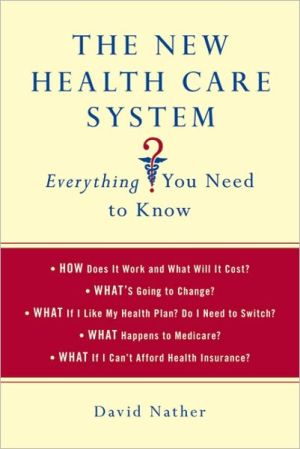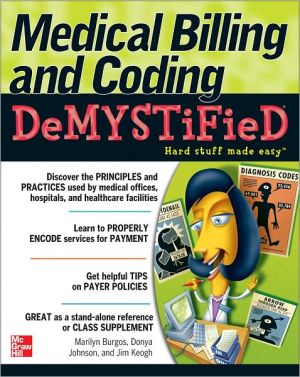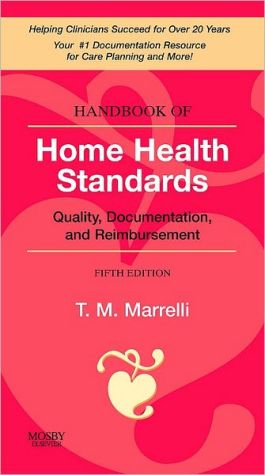The New Health Care System: Everything You Need to Know
Now that the health care reform bill has become the law of the land, millions of Americans will need help figuring out exactly how the new system will work and how it might affect their lives. \ This guide will teach people how the new health care exchanges are supposed to work. In an easy, conversational manner, David Nather makes a complicated system easier to understand by answering all your questions. Such as:. \ *How to apply for help in paying for...
Search in google:
A primer in plain English that explains how healthcare will work under the new legislation and how it will affect your care and your choices going forward. Publishers Weekly Starred Review. Providing clear, concise answers to countless questions about sweeping health care reform signed into law by President Obama in early 2010, Nather, a senior writer for Congressional Quarterly, has created an indispensible guide. From changes in Medicare and Medicaid to issues of long-term care, from health insurance exchanges to financial assistance for premiums, Nather's handbook addresses all essential topics in a manner more thorough than anything provided so far by news sources. With easy-reference headings, tables for coverage dates, numerous web and phone resources for further facts, and more, this will be a valuable resources in the coming years as the law's changes roll into effect. In addition to the mechanics of reform, Nather addresses preventive care, medical decision-making, cost-cutting, and even paying for health care reform. His efficient, humorous, nonpartisan prose - succinct yet highly detailed - makes this an indispensable guide for anyone unsure of what "The Patient Protection and Affordable Health Care Act" will mean to them. Copyright © Reed Business Information, a division of Reed Elsevier Inc. All rights reserved.
1\ How Health Insurance Works Someone has to pay for the health care we all receive. But health care is expensive, and it’s getting more expensive all the time. Some of the increase in costs is for good reasons, such as the new and better medical technologies, procedures, and drugs that are coming out all the time. And some of it is for lousy reasons, such as the doctors who give us more tests and procedures than we really need, and the fact that we tend to pay doctors by how many services they perform rather than how effectively they treat us. For all of these reasons, health care would bankrupt all but the richest of us if we didn’t have help paying for it.\ Health insurance is the way we spread the cost of everyone’s health care and help each other pay for it. It’s not supposed to give us free health care. Most of us pay premiums for our coverage—though they’re kept low in public programs for low-income people—in order to maintain a pool of money. But insurance is supposed to shield us from the highest costs of health care when we’re sick or injured. Some of us will always pay more into our health coverage than we get back, if we’re lucky and don’t use the health care system much. Some of us get back more than we pay in. But that’s the way the social contract of health insurance works: We pay to help ourselves and other people, and when we need help, others help to pay for us.\ There are many different forms of health coverage. Most of us get private health insurance through the workplace, and usually our employer shares the costs with us. (Some of them are more generous than others.) And some of us take our chances getting private insurance policies for ourselves, if our workplace doesn’t provide it or if we don’t have a workplace to get it through. But many of us get it through public programs. If we’re sixty-five or older, we get it through Medicare, that government-run health care program for most elderly people and younger people with disabilities. If we’re poor or close to the poverty line, and we fall into certain categories, we might get health coverage through Medicaid—which is run by the federal government and the states—and our kids might be covered through the State Children’s Health Insurance Program. If we’re serving in the military, we get it through TRICARE, and after our service is over, we’ll get it through the Veterans Administration.\ It’s a fragmented system, with different rules for the public programs and 1,300 private health insurance plans. But it evolved that way because those were the collective choices we have made as a country. We have accepted a unified system of coverage for one group—the elderly—under the Medicare program, but generally resisted it otherwise. Most of us have had private health insurance through the work-place since World War II, and most Americans have grown used to that system and want to keep it. For that matter, most Americans prefer private health insurance in general. That’s why, except for vulnerable groups such as the elderly and the poor, our political system has resisted any big expansion of the role of government in health care.\ But there are certain things that all forms of health coverage have in common. To work well, they have to spread the costs of the healthy and the sick so that it all more or less averages out. If any health insurance plan can’t do that, it risks losing all the healthy people and keeping only the ones who have lots of health problems. In the health care industry, this is called “adverse selection.” It’s not a problem for programs with large pools of people, such as Medicare, because they have enough participants to spread the costs fairly easily. And it’s not a big problem for any private insurance plan with lots of people in it, such as a large company’s health care plan. But the smaller the pool, the bigger the problem becomes. That’s one reason why small businesses have so much trouble finding affordable coverage for their workers. And that’s why anyone in an individual or family health insurance plan is the most vulnerable of all—because there is no one else to share the risks with you.\ “Death Spirals” and Preexisting Conditions If a health insurance plan gets stuck with mostly people who need a lot of health care, and few healthy people to help share those costs, it has to bring more money in to cover the expenses. That means raising the premiums. So suddenly everyone in the plan is paying more every month just to keep their insurance. The healthy people might decide to leave and find another plan that won’t charge them so much, or they might just go without coverage. If this continues long enough, it creates what’s called a “death spiral,” where the pool of people gets smaller and smaller until only the people with the costliest health conditions are left. This is why private health insurance companies go to such lengths to keep their pool of people, on average, as close to the general health of the population as possible.\ Other countries that also have competing health insurance plans face the same dilemma. They, too, have to find ways to keep enough money coming in to cover all of their costs. But in the United States, we have another factor on top of that: the profit motive. Ours is the only industrialized country that bases so much of its health care system on private health insurance companies that have to answer to their shareholders. Even in Germany, where the health plans are called “sickness funds” and compete for customers much like ours do, the health plans aren’t allowed to make profits. Instead, they compete in other ways, such as offering extra benefits or paying claims faster than the other plans.\ All of this helps explain why health insurance companies in this country have used tactics that have made them so unpopular. They have tried to avoid paying for the people who need health care the most. They have refused to cover people with “preexisting conditions,” or refused to cover the conditions themselves, or made people go through a waiting period before the conditions would be covered. In some of the most notorious cases, they have used a practice called “rescissions”: cancelling people’s coverage retroactively if they found a crucial, and sometimes not so crucial, piece of information that the patient didn’t disclose when he applied for coverage.\ These are the kinds of extremes that insurance companies have gone to in order to avoid attracting too many expensive patients, and that’s what the new health care reform law is supposed to prevent from happening. But the pressures will always be there for insurance companies to cover their costs and keep them as stable as possible. If they can’t keep you out of their plan for having a health condition, and they can’t hike your individual premiums through the roof so you’ll take the hint and leave their pool—two practices that would be banned under the new law—they can just make everyone’s premiums more expensive. But now that everyone will be required to have health insurance, and insurers can get lots of young and healthy new customers, they may not feel the need to raise premiums for everyone to cover the most expensive customers. But if lots of healthy people avoid the new requirement, the insurance companies could charge everyone higher premiums and say they had no choice.\ \ Different Kinds of Private Health Plans\ \ • Health Maintenance Organization (HMO): A health care system that provides health care through a tight network of doctors and hospitals and assumes the financial risk for the services. You’re likely to face the most restrictions in this model, since you have to stay within the network, but you probably will pay less for the coverage.\ • Preferred Provider Organization (PPO): A health plan that uses looser networks of doctors and hospitals. You’ll probably have a greater selection with this kind of plan, but you’ll have to pay more for it. You can also go outside the network and pay a greater share of charges for services.\ • Point of Service (POS): A hybrid between an HMO and a PPO, in that it acts more like an HMO within the network of doctors and hospitals and like a PPO outside the network.\ • Fee for Service (FFS): The oldest kind of health insurance plan, in which the patient chooses any doctor or hospital and the insurance simply pays for the services rendered. This kind of insurance fell out of favor when businesses began to turn to managed care plans, which monitor costs more closely before deciding whether to cover them.\ • Health Savings Account (HSA): A special account that allows people to save money on a pre-tax or tax-deductible basis and use it to pay for their health care expenses up to a certain level. An HSA is used together with high-deductible health plans, which have lower premiums than other plans but don’t cover your health costs until you’ve spent a fairly large amount of money on your own. As of 2010, these plans had to have deductibles of at least $1,200 for individual coverage and $2,400 for family coverage.\ How to Look for Insurance Even under the new system, you’ll encounter some basic trade-offs when shopping for private health insurance. Here’s the biggest one: The more you want to avoid paying for medical expenses out of pocket, the higher your premiums will be. When choosing a plan, one of your most important decisions will be how often you think you’ll need to see a doctor, and how much of a risk you want to take on high out-of-pocket expenses in order to keep your monthly premiums low.\ With any health insurance plan, you pay in several different ways. You pay your monthly premium to maintain the coverage, but you’ll also pay something on your own to share the expenses of the medical care. Depending on the plan, you might pay any or all of the following: copayments for visits to the doctor or hospital, copayments for prescription drugs, coinsurance (where you pay a certain percentage of the bill), or a deductible (where your coverage kicks in only after you’ve paid a certain amount out of pocket).\ If you’re looking at a selection of health plans, and you’re tempted to pick the one with the cheapest monthly premium, take a closer look. There’s probably a reason why it’s so cheap. Most likely the copayments, coinsurance, or deductibles—and maybe all three—will be higher than under a more generous plan with a higher premium. That might be the right risk for you to take. If you don’t expect you or your family to have many health care needs, it may not make much sense to pay a lot in premiums each month. But if you do run into an unexpected medical emergency, you might be exposed to more costs than you would have been under a plan with higher premiums.\ This is an especially big problem for people buying health insurance on their own rather than getting it through the workplace. If you get health coverage at work, you probably won’t have a wide range of choices—an HMO and a PPO from the same insurance company might be your only options. But they probably will protect you fairly well, if you work for a medium-size or large company that treats its employees well. If you work for a small business or a retail chain that doesn’t provide a lot of benefits, or if you’ve just lost a job and need to get coverage on your own, you need to be on the lookout for bad deals.\ One of the biggest problems has been the rise of “limited benefit” health plans, which are advertised as a way for people to get at least some coverage at an affordable price. They’re offered to people buying health insurance on their own, but they’re especially popular among businesses with hourly workers who wouldn’t be able to offer them any coverage otherwise. The catch, of course, is that “limited benefit” means exactly what it says. The plans might have extremely tight limits on how much they’ll pay in a given year, or low limits on how much they’ll pay for each day in a hospital. So if you go over that limit—which is likely with any kind of serious medical problem—you’ll be stuck with the remaining bills.\ Limited benefit plans have had strong political appeal in recent years, especially in Florida, where the state created the Cover Florida Health Care Access Program in 2008 to offer cheap coverage to uninsured people. But look closely at the plans, and you’ll understand why they’re so cheap. One carrier, for example, offers two plans with no prescription drug coverage, and two that cover drugs but only pay up to $1,000 a year for them. One plan covers only $40,000 a year in total medical benefits. The carrier’s “preventive” plans don’t cover hospital inpatient services at all, while its “catastrophic” plans charge $500 in copayments for the first five days. And if you needed emergency care at a hospital in your network, you could expect to pay a $250 copayment for it. Those are much higher copayments, and much lower coverage limits, than you’d find in a typical comprehensive health care plan, the kind offered by most reputable companies.\ The new health care law is supposed to crack down on these kinds of skimpy benefits by defining a new minimum of what health plans for individuals and small businesses should cover. Those requirements would apply only to plans offered after 2014 by the new health insurance exchanges, which will be Web-based marketplaces where you can go in every state for one-stop shopping for health insurance. But the hope is that most insurance companies will phase out the limited benefit plans so all of their products will be in line with what’s offered in the exchanges. This could take a while, though. So for the time being, it’s a good idea to keep your eyes open so you don’t get stuck with a lot less protection than you thought you had.\ In 2009, Consumers Union came out with a handy list of seven clues that a health plan might be “junk”—not enough protection for the money you’re paying in premiums. The new law should stop most of these practices eventually, but the biggest changes don’t kick in for a few years. So until that happens, it’s worth keeping the following tips in mind as you look over your options:\ \ 1. Never buy coverage that calls itself a “limited benefit” plan or “not major medical” insurance.\ 2. Watch out for anything that has low limits on the total benefits it will pay out. Even $100,000 won’t protect you from a big financial hit if you or a member of your family has a major illness.\ 3. Look out for any plan where the premium seems unusually low.\ 4. Read the plan carefully to make sure all major items are covered, especially basic benefits such as prescription drugs. If you don’t see it mentioned, it probably isn’t covered.\ 5. Watch for tight limits on what a plan covers for certain types of care, such as a dollar limit on how much it covers for each day in the hospital.\ 6. Make sure it mentions an “out-of-pocket maximum”—how much you have to pay yourself before the plan starts covering everything. And watch out for loopholes in the plan, such as not counting copayments toward your out-of-pocket limit.\ 7. Look closely for any unusual limits, such as not covering hospital care until the second day.\ \ Loopholes Even when you’re comparing comprehensive plans that don’t have big gaps in coverage, there can be loopholes that seem minor but will make a big difference if you get seriously ill. The new law should make these less likely, but it’s a good idea to know what to look for in the meantime—and to be an informed consumer so you can keep your eyes open even under the new system.\ The issue of what counts toward your out-of-pocket limit, for example, is an important one. Some health plans count your deductible and coinsurance payments toward that limit, but not the copayments that you hand over every time you visit a doctor’s office or the hospital. In those cases your “out-of-pocket limit” isn’t what you think it is. And over time, if you have a major illness or injury, those copayments can add up quickly. So when comparing two plans, if they seem pretty much the same, but one counts copayments toward the out-of-pocket limit and the other doesn’t, your best choice is the plan that counts them.\ For most people who haven’t had a lot of health problems, the hardest thing to do is to anticipate how much protection you would have under any given health plan—and how much you would have to pay on your own—if you were unlucky enough to suffer a serious illness. But that’s exactly what you have to think about when buying health insurance. After all, it’s not the occasional cold or flu that could bankrupt you. A woman who is diagnosed with breast cancer, for example, faces treatment costs that can easily run into six figures, not counting insurance coverage. A May 2009 study by the Georgetown University Health Policy Institute and the Center for American Progress Action Fund calculated that a breast cancer patient could face eighty-seven weeks of treatment, costing a total of $97,298 in California and $143,180 in Massachusetts—before any insurance was counted—because of the differences in what doctors around the country charge for their services.\ So it’s important to find a plan that protects you from as many of those expenses as possible. But when the Georgetown researchers studied actual individual health insurance policies in those two states, they found that a breast cancer patient in Massachusetts would pay two wildly different amounts on her own under two plans that were similar in almost every way. The big difference: One plan counted copayments toward the out-of-pocket limit, the other didn’t. Under the plan that counted copayments toward the limit, the breast cancer patient would have paid $7,641 over the course of her treatment. That’s a lot for anyone to pay, but it’s not as much as she would have paid under the plan that didn’t count copayments. If she had signed up for that one, she would have paid $12,907 on her own.\ The Massachusetts example is an important one, because that state has a system similar to what the new health care law is trying to create throughout the country. In 2006, the state reformed its health care system to set up a “Health Connector,” an exchange that offers health insurance to individuals and small businesses in Massachusetts—much like the exchanges the new federal law creates for everyone. It standardizes the kinds of benefits plans offer, so all plans fit into one of four categories: gold, silver, bronze, and “young adult.” The gold plans offer the most generous coverage but cost the most each month, while the young adult plans offer the least protection but also cost the least. But even when the differences between the plans are narrowed that much, they still have subtle distinctions that could matter greatly to someone who got seriously ill. That’s why it’s a good idea to learn as much as you can about the fine print before you sign up.\ \ Excerpted from The New Health Care System by David Nather.\ Copyright 2010 by David Nather.\ Published in 2010 by St. Martin's Griffin.\ All rights reserved. This work is protected under copyright laws and reproduction is strictly prohibited. Permission to reproduce the material in any manner or medium must be secured from the Publisher.
Introduction 11 How Health Insurance Works 62 Fixing the Insurance Market 253 Everyone Has to Have Health Coverage 374 Getting Help Paying for Coverage 485 What Employers Have to Do 616 The New Health Insurance Exchanges 717 What's Left of the Public Option? 878 While You're Waiting... 959 Medicare Changes 10810 The Expansion of Medicaid 11911 Long-Term Care 13012 Preventive Care and Wellness 14113 Who Decides What Care You Get? 14914 How They'll Cut Costs 15815 How They'll Pay for It 172Appendix 195Acknowledgments 219Index 223
\ Publishers WeeklyStarred Review. \ Providing clear, concise answers to countless questions about sweeping health care reform signed into law by President Obama in early 2010, Nather, a senior writer for Congressional Quarterly, has created an indispensible guide. From changes in Medicare and Medicaid to issues of long-term care, from health insurance exchanges to financial assistance for premiums, Nather's handbook addresses all essential topics in a manner more thorough than anything provided so far by news sources. With easy-reference headings, tables for coverage dates, numerous web and phone resources for further facts, and more, this will be a valuable resources in the coming years as the law's changes roll into effect. In addition to the mechanics of reform, Nather addresses preventive care, medical decision-making, cost-cutting, and even paying for health care reform. His efficient, humorous, nonpartisan prose - succinct yet highly detailed - makes this an indispensable guide for anyone unsure of what "The Patient Protection and Affordable Health Care Act" will mean to them.\ Copyright © Reed Business Information, a division of Reed Elsevier Inc. All rights reserved.\ \ \







